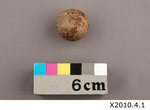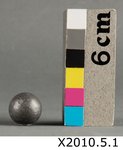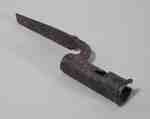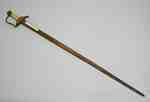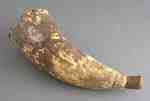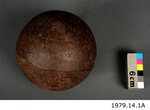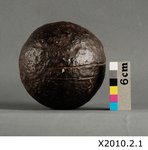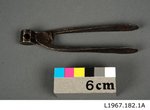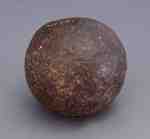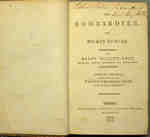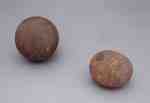Results
- This is an example of ammunition used in artillery during the War of 1812. Commonly termed a grapeshot, this round grayish ball of lead has a circumference of 3 3/4 inches. The surface is not smoothThis is an example of ammunition used in artillery during the War …
- This type ammunition was used in a musket during the War of 1812. A small round silver ball of lead, this musket ball is 2 1/8 inches in circumference. The surface is shiny and smooth with a visibleThis type ammunition was used in a musket during the War of …
- This musket, circa1812, with its ramrod attached, is a flintlock converted to a percussion steel firing mechanism. The barrel is steel and the stock is made of walnut. The marks include: the HanoveriThis musket, circa1812, with its ramrod attached, is a flintlock converted to …
- This is a bayonet socket with a portion of the blade attached that was discovered in the Niagara River. A bayonet is a steel blade that is designed to fit on the muzzle of a rifle or musket barrel, mThis is a bayonet socket with a portion of the blade attached …
- This is a fragment of a triangular bayonet blade, dated from the War of 1812-1814, that was discovered in the Niagara River. A bayonet is a steel blade that is designed to fit on the muzzle of a riflThis is a fragment of a triangular bayonet blade, dated from the …
- This sword is made of metal and ivory with the blade measuring 81 cm and the handle 13 cm. It is a British regulation issue sword, circa 1796-1820, that could have been used by local militia troops dThis sword is made of metal and ivory with the blade measuring …
- This sabre is made of metal, leather and wood. Along with its scabbard, the sabre was made by Woolley, Deakin, Dutton, & Johnson, as it is inscribed on one end of the scabbard. This scabbard is madeThis sabre is made of metal, leather and wood. Along with its …
- A hand-made powder horn, dated approximately 1800, that is believed to have existed since 1790. Both the flask and the stopper are made wood. For more information, read “‘Scruples of Conscience’: TheA hand-made powder horn, dated approximately 1800, that is believed to have …
- A small copper flask that was presumably used for gun powder. There is a brass rim at the opening and a metal lever to open it. The design on the face is the same on both sides: Trees, a hunter and aA small copper flask that was presumably used for gun powder. There …
- A cannonball of this type would have been used during the War of 1812. This brown, iron cannonball is 16 inches in circumference and approximately 5 inches in diameter. The surface is of the cannonbaA cannonball of this type would have been used during the War …
- This type of cannon ball was used during the War of 1812. This round, black ball of iron has a pitted surface and is 14 1/2 inches in circumference and 5 inches in diameter. There is a 4 mm wide andThis type of cannon ball was used during the War of 1812. …
- A musketball mould of the type made and used pre-1830. An iron, plier-like tool with two handles. At the end of each handle is a mini-pan with semi-spherical moulds inside. When the two handles are bA musketball mould of the type made and used pre-1830. An iron, …
- This is an officer’s sword that has the inscription “Capt’n Daniel Servos, Butler’s Rangers 1778” on its scabbard. The hilt is silver and green with an eagle on the pommel. The sword was donated to tThis is an officer’s sword that has the inscription “Capt’n Daniel Servos, …
- This is an ammunition chest made of wood, canvas and iron, and measures 272.5 x 56.3 x 52.5 CM. It has a curved lid covered with canvas with iron strapping, and angled iron on the four corners with iThis is an ammunition chest made of wood, canvas and iron, and …
- This large copper powder flask has a brass rim and spout at the top. Below the spout is marked "Dixon & Sons", the Manufacturer. The spout is marked: "DRAMS 4 1/2 4 1/2 4 3 3/4 3 1/2. Below the spoutThis large copper powder flask has a brass rim and spout at …
- Cannonball that was found at the south end of Elm Street, near the lake, in Port Colborne. It is believed that military stores and munitions were often kept in the Sugar Loaf area and would be quicklCannonball that was found at the south end of Elm Street, near …
- A practical military manual for officers in the Royal Regiment of Artillery. It combines training and field service manuals with lists of equipment, weights, dimensions, and equipment accuracy and peA practical military manual for officers in the Royal Regiment of Artillery. …
- Two cannonballs, one smaller and lopsided was found in a backyard on Catharine Street in Port Colborne and the other larger one was found elsewhere in the city. It is believed that military stores anTwo cannonballs, one smaller and lopsided was found in a backyard on …
- These five musket balls were found on Nickel beach at a home on Lakeshore Road East, Port Colborne Ontario. It is believed that during the War of 1812 many military stores and munitions were secretedThese five musket balls were found on Nickel beach at a home …
- This set of four cannonballs were found at Gravelly Bay in Port Colborne. It is believed that the cannonballs were found here because of their proximity to Zavitz Mill. During the war, the mill wouldThis set of four cannonballs were found at Gravelly Bay in Port …
When selecting an individual record or object, you will move
to the website of the heritage institution that houses the item.
To return to the search or results pages, select "Back", "Results" or "New Search".
 This project was made possible with the support of the Department of Canadian Heritage
This project was made possible with the support of the Department of Canadian Heritage
through the Canadian Culture Online Strategy.
to the website of the heritage institution that houses the item.
To return to the search or results pages, select "Back", "Results" or "New Search".
 This project was made possible with the support of the Department of Canadian Heritage
This project was made possible with the support of the Department of Canadian Heritage through the Canadian Culture Online Strategy.






